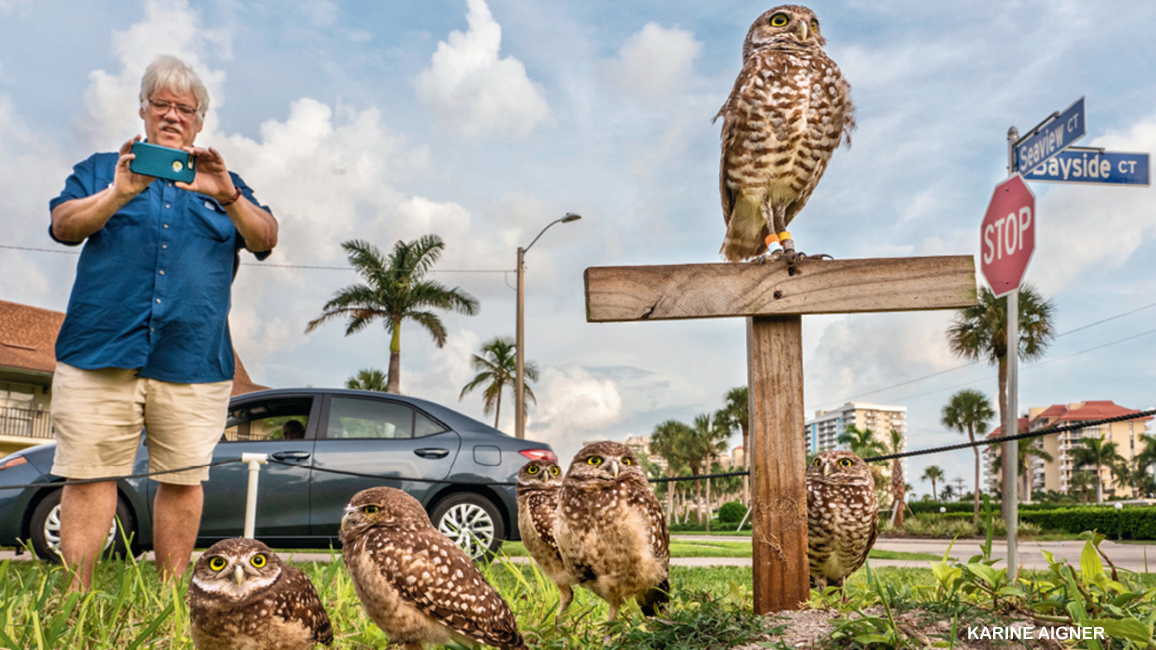
Owl Patrol
By Ellen Lambeth; Photos by Karine AignerPeople in this community have owls for neighbors. And they love keeping watch over their feathered friends.

Burrowing owls have the perfect name: When it’s time to raise families, they really DO dig holes in the ground! Check out the members of one owl family at the edge of their burrow in the photo above. Their home is just another home in this friendly neighborhood.
You might see burrowing owls throughout the western half of the United States. They travel as far north as Canada to breed and as far south as Central America for the winter. But the birds in this story are Florida burrowing owls, and they stick around all year. Come meet the burrowers of Marco Island, Florida—AND the special people who watch over them.

Home, Sweet Home
Burrowing owls nest underground in open areas such as fields, plains, and prairies. Out West, they often use old burrows that other animals—such as prairie dogs, badgers, or tortoises—have already dug. But here in Florida, they usually dig their own. A burrow may be up to 3 feet deep and 12 feet long. Not bad for a bird shorter than a Barbie doll! Their main problem is finding places to dig.
All across the country, open space is rapidly disappearing as towns and businesses grow. That’s especially true here in Marco Island, where more and more people are moving in and taking over the land. Good thing some of those people care—a LOT—about their owl neighbors!
Owl Watchers
About 20 years ago, there were very few owls still nesting in Marco Island. Now, there are hundreds! You can thank a group of volunteers for that. They’re all part of a program called Owl Watch, run by a group called Audubon of the Western Everglades.
The volunteers learn all about the birds and their needs. They also monitor them. That means they keep an eye out for owls and for new burrows. It helps that burrowing owls can be out and about at any time of day or night. (Most other owls are active at night.) The volunteers follow a schedule for each neighborhood, checking known burrows and keeping a record of every visit. They also report any burrows in danger, such as one in a vacant lot that’s about to be built on. After all, these birds are listed as a threatened species and protected by law.

Owl in the Family
Owl Watch’s youngest volunteers are 10-year-old Calvin and his sister, Tosca, who is 9. Along with their mom, they monitor 16 burrows. Calvin is especially good at spotting new burrows. Each one gets roped off to keep people from getting too close to the birds or accidentally smushing the burrows. Volunteers add a little wooden perch near the entrance. The owls like to sit up there and look around for a meal, such as an insect, a frog or lizard, or a little rodent.
The bad news is that the birds keep running out of vacant places to burrow. To help out, people can invite the birds into private yards by digging a little way into the ground there. The owls seem to like these “starter burrows.” And the human neighbors welcome their new feathered neighbors.
Bring on the Science
So, volunteers are monitoring Marco Island’s burrowing owls. But that’s only half the job. The other half requires getting up close and personal with them. That’s where Allison Smith comes in. Alli is Owl Watch’s scientist. She uses all the information gathered by the volunteers. She also often captures chicks so she can put ID bands on their legs. As the chicks grow up and move out on their own, the bands let her and others continue to keep track of them. Before Alli lets the chicks go, she checks their health and growth. With friends like these, the owls of Marco Island are getting a big boost. No wonder they’re surviving and thriving!
Rangers: For more info, have an adult visit audubonwe.org/our-work/owl-watch. —R.R.
















